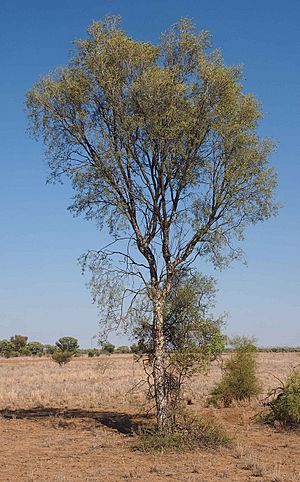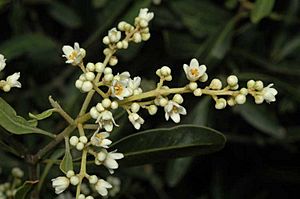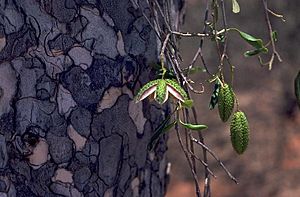Leopardwood facts for kids
Quick facts for kids Leopardwood |
|
|---|---|
 |
|
| Flindersia maculosa | |
| Scientific classification | |
| Genus: |
Flindersia
|
| Species: |
maculosa
|
| Synonyms | |
|
|
Flindersia maculosa, often called leopardwood or leopard tree, is a special tree. It grows in inland areas of eastern Australia. This tree is part of the Rutaceae family, which includes citrus fruits. It gets its name from its cool, spotty bark. It has simple leaves, white or cream-colored flowers, and fruits with rough bumps.
Contents
What Leopardwood Looks Like
Leopardwood trees can grow up to 15 meters (about 49 feet) tall. When they are young, they start as a tangled bunch of spiny branches.
Bark and Leaves
The trunk of the leopardwood tree has a unique, mottled look. This is because its bark peels off in patches, creating a spotted pattern. Its leaves are simple and grow in pairs. They are usually long and narrow, about 10 to 80 millimeters (0.4 to 3.1 inches) long. The top of the leaf is shiny and dark green, while the bottom is dull and lighter.
Flowers and Fruit
The flowers of the leopardwood tree are white to cream-colored. They grow in clusters at the ends of the branches. Each flower has small sepals and petals. These trees usually bloom from September to December. After flowering, they produce a woody fruit. This fruit is like a capsule covered in rough points. When it's ready, it splits into five parts. Inside, it releases winged seeds that are about 18 millimeters (0.7 inches) long.
How Leopardwood Got Its Name
The leopardwood tree was first officially described in 1848. A scientist named John Lindley wrote about it. Later, in 1963, George Bentham gave it the scientific name Flindersia maculosa.
Where Leopardwood Grows
You can find Flindersia maculosa growing on stony hills and sandy plains. It lives in a large area of eastern Australia. This includes places from Hughenden in central Queensland down to the Riverina district in New South Wales. It also grows from Walgett to Ivanhoe and Broken Hill in New South Wales.
Uses of Leopardwood
Leopardwood is a helpful tree, especially during dry times. Farmers sometimes use its leaves as food for animals when other plants are scarce. However, it's important to trim the tree carefully so it can grow back healthy.
Wood and Drinks
The wood from the leopardwood tree is strong. People sometimes use it to make fence posts or handles for tools like pickaxes. The tree also offers sweet treats! Nectar from its flower buds and a gum from its bark can be used to make a sweet drink. This drink made from the gum has even been used as a traditional remedy for upset stomachs.
Leopardwood in Nature
Many creatures interact with the leopardwood tree.
- The caterpillars of a moth called Opodiphthera astrophela love to eat the leaves of the leopardwood tree.
- A type of beetle from the Anilara group can sometimes cause a lot of damage to these trees.
- A special plant called Amyema lucasii, which is a type of mistletoe, almost always grows on Flindersia maculosa trees.
- Large birds like the wedge-tailed eagle sometimes build their nests in the strong branches of leopardwood trees.
Protecting Leopardwood
The Queensland Government has looked at the Flindersia maculosa tree. They have classified it as being of "least concern" under the Nature Conservation Act 1992. This means that for now, there are enough of these trees, and they are not considered to be in danger.
Images for kids
-
A wedge-tailed eagle's nest in a fruiting leopardwood tree at Mutawintji National Park
See also
 In Spanish: Árbol leopardo para niños
In Spanish: Árbol leopardo para niños






